Practice Corner MCQs
Quiz Summary
0 of 96 Questions completed
Questions:
Information
You have already completed the quiz before. Hence you can not start it again.
Quiz is loading…
You must sign in or sign up to start the quiz.
You must first complete the following:
Results
Results
0 of 96 Questions answered correctly
Your time:
Time has elapsed
You have reached 0 of 0 point(s), (0)
Earned Point(s): 0 of 0, (0)
0 Essay(s) Pending (Possible Point(s): 0)
Categories
- Not categorized 0%
- 1
- 2
- 3
- 4
- 5
- 6
- 7
- 8
- 9
- 10
- 11
- 12
- 13
- 14
- 15
- 16
- 17
- 18
- 19
- 20
- 21
- 22
- 23
- 24
- 25
- 26
- 27
- 28
- 29
- 30
- 31
- 32
- 33
- 34
- 35
- 36
- 37
- 38
- 39
- 40
- 41
- 42
- 43
- 44
- 45
- 46
- 47
- 48
- 49
- 50
- 51
- 52
- 53
- 54
- 55
- 56
- 57
- 58
- 59
- 60
- 61
- 62
- 63
- 64
- 65
- 66
- 67
- 68
- 69
- 70
- 71
- 72
- 73
- 74
- 75
- 76
- 77
- 78
- 79
- 80
- 81
- 82
- 83
- 84
- 85
- 86
- 87
- 88
- 89
- 90
- 91
- 92
- 93
- 94
- 95
- 96
- Current
- Review
- Answered
- Correct
- Incorrect
-
Question 1 of 96
1. Question
Synthesis of complex organic substances from simple inorganic raw materials in the presence of sunlight and chlorophyll is called as , which is a process.
CorrectIncorrectHint
(a) Photosynthesis is an enzyme regulated anabolic process which involves the synthesis of organic compounds, inside the chlorophyll containing cells, from \(\mathrm{CO}_2\) and \(\mathrm{H}_2 \mathrm{O}\) with the help of sunlight as a source of energy. Oxygen evolved during photosynthesis comes from water. The equation for photosynthesis can be summarised as follows:
\(
6 \mathrm{CO}_2+12 \mathrm{H}_2 \mathrm{O} \underset{\text { Radiant energy }}{\stackrel{\text { Chlorophyll }}{\longrightarrow}}
\mathrm{C}_6 \mathrm{H}_{12} \mathrm{O}_6+6 \mathrm{H}_2 \mathrm{O}+6 \mathrm{O}_2 \uparrow
\) -
Question 2 of 96
2. Question
Which one of the following correctly depicts the biochemical reaction for photosynthesis?
CorrectIncorrectHint
(d) Photosynthesis is an enzyme regulated anabolic process which involves the synthesis of organic compounds, inside the chlorophyll containing cells, from \(\mathrm{CO}_2\) and \(\mathrm{H}_2 \mathrm{O}\) with the help of sunlight as a source of energy. Oxygen evolved during photosynthesis comes from water. The equation for photosynthesis can be summarised as follows:
\(
6 \mathrm{CO}_2+12 \mathrm{H}_2 \mathrm{O} \underset{\text { Radiant energy }}{\stackrel{\text { Chlorophyll }}{\longrightarrow}}
\mathrm{C}_6 \mathrm{H}_{12} \mathrm{O}_6+6 \mathrm{H}_2 \mathrm{O}+6 \mathrm{O}_2 \uparrow
\) -
Question 3 of 96
3. Question
Moll’s half-leaf experiment proves that ____ is essential for photosynthesis to take place.
CorrectIncorrectHint
b
-
Question 4 of 96
4. Question
Who demonstrated that green plants purify the foul air produced by breathing animals and burning candles?
CorrectIncorrectHint
(a) Joseph Priestley (1770) observed that a burning candle and mouse were kept together in a closed space – a bell jar, the candle soon gets extinguished. Similarly, the mouse soon get suffocated and die. However, when he placed a mint plant in the same bell jar, he found that the mouse stayed alive and candle continued to burn. Priestley hypothesised that foul air or phlogiston produced during burning of candles or animal (mice) respiration could be converted into pure air or dephlogiston by plants (mint). In 1774, Priestley discovered oxygen.
-
Question 5 of 96
5. Question
Which of the following scientists concluded by his experiments that green plant parts play a role in purifying the noxious air only in the presence of sunlight?
CorrectIncorrectHint
(b) Jan Ingenhousz, in his experiment on an aquatic plant, showed that in bright sunlight, small bubbles were formed around the green parts while in the dark, no such bubbles formed. He found out these bubbles to be of oxygen. He thus, confirmed that the purification of air or formation of dephlogiston is carried out by green plants only in the presence of sunlight.
-
Question 6 of 96
6. Question
Ingenhousz in an experiment showed that in bright sunlight, small bubbles were formed around the green parts of the plant, while in the dark, they did not. He identified these bubbles to be of
CorrectIncorrectHint
(c) Jan Ingenhousz, in his experiment on an aquatic plant, showed that in bright sunlight, small bubbles were formed around the green parts while in the dark, no such bubbles formed. He found out these bubbles to be of oxygen. He thus, confirmed that purification of air or formation of dephlogiston is carried out by green plants only in presence of sunlight.
-
Question 7 of 96
7. Question
Who provided the evidence that glucose is formed during photosynthesis and is then stored in the form of starch?
CorrectIncorrectHint
(a) Sachs provided the evidence that green plant parts produce glucose which is stored in the form of starch. Starch is the first visible product of photosynthesis.
-
Question 8 of 96
8. Question
Who used prism, green alga Cladophora and aerobic bacteria and plotted the first action spectrum for photosynthesis?
CorrectIncorrectHint
(d) Engelmann split light into its spectral components by the prism and then illuminated Cladophora (a green alga) was placed in a suspension of aerobic bacteria. The bacteria were used to detect the sites of \(\mathrm{O}_2\) evolution. He found that bacteria accumulated in the region of blue and red light of the split spectrum. He thus, discovered the effect of different wavelengths of light on photosynthesis and plotted the first action spectrum of photosynthesis.
-
Question 9 of 96
9. Question
Who, after conducting experiments on purple and green sulphur bacteria, inferred that \(\mathrm{O}_2\) evolved during photosynthesis comes from \(\mathrm{H}_2 \mathrm{O}\) not from \(\mathrm{CO}_2\)?
CorrectIncorrectHint
(c) van Niel, on the basis of his studies with purple and green sulphur bacteria, demonstrated that photosynthesis is a light dependent reaction in which hydrogen from an oxidisable compound reduces \(\mathrm{CO}_2\) to form sugar.
\(
2 \mathrm{H}_2 \mathrm{~A}+\mathrm{CO}_2 \stackrel{\text { Light }}{\longrightarrow} 2 \mathrm{~A}+\mathrm{CH}_2 \mathrm{O}+\mathrm{H}_2 \mathrm{O}
\)
In green sulphur bacteria, when \(\mathrm{H}_2 \mathrm{~S}\) instead of \(\mathrm{H}_2 \mathrm{O}\) was used as hydrogen donor, \(\mathrm{no} \mathrm{O}_2\) was evolved.
\(
6 \mathrm{CO}_2+12 \mathrm{H}_2 \mathrm{~S} \longrightarrow \mathrm{C}_6 \mathrm{H}_{12} \mathrm{O}_6+6 \mathrm{H}_2 \mathrm{O}+12 \mathrm{~S}
\)
From the above observation, van Niel proposed that oxygenic photosynthesis of all organisms is actually an oxidation-reduction reaction involving the action of hydrogen of water over carbon dioxide to form organic compounds. He also propounded that oxygen evolved from water. -
Question 10 of 96
10. Question
Which one of the following equations suggests that \(\mathrm{O}_2\) released during photosynthesis comes from water?
CorrectIncorrectHint
(d) Ruben and Kamen, while working on Chlorella (unicellular green alga) found that oxygen liberated during photosynthesis comes from water.
(i) When normal \(\mathrm{H}_2 \mathrm{O}\) and radioactive \(\mathrm{CO}_2\) (i.e., \(\mathrm{CO}_2^{18}\) ) were used, normal \(\mathrm{O}_2\) is evolved.
\(
n \mathrm{CO}_2^{18}+n \mathrm{H}_2 \mathrm{O} \frac{\text { Light }}{\text { Chlorophyll }}\left(\mathrm{CH}_2 \mathrm{O}^{18}\right)_n+n \mathrm{O}_2 \uparrow(\text { normal })+\mathrm{H}_2 \mathrm{O}
\)
(ii) When normal \(\mathrm{CO}_2\) and radioactive \(\mathrm{H}_2 \mathrm{O}\left(\right.\) i.e., \(\left.\mathrm{H}_2 \mathrm{O}^{18}\right)\) were used, radioactive \(\mathrm{O}_2\) (i.e., \(\mathrm{O}_2^{18}\) ) is evolved.
\(
\mathrm{nCO}_2+\mathrm{nH}_2 \mathrm{O}^{18} \longrightarrow\left(\mathrm{CH}_2 \mathrm{O}\right)_n+\mathrm{O}_2^{18} \uparrow \text { (radioactive oxygen) }+\mathrm{H}_2 \mathrm{O}
\) -
Question 11 of 96
11. Question
If green plant cells are incubated with \(0^{18}\)-labelled water, which of the following molecules will become radioactive when the cells are exposed to light?
CorrectIncorrectHint
(a) Ruben and Kamen, while working on Chlorella (unicellular green alga) found that oxygen liberated during photosynthesis comes from water.
(i) When normal \(\mathrm{H}_2 \mathrm{O}\) and radioactive \(\mathrm{CO}_2\) (i.e., \(\mathrm{CO}_2^{18}\) ) were used, normal \(\mathrm{O}_2\) is evolved.
\(
n \mathrm{CO}_2^{18}+n \mathrm{H}_2 \mathrm{O} \frac{\text { Light }}{\text { Chlorophyll }}\left(\mathrm{CH}_2 \mathrm{O}^{18}\right)_n+n \mathrm{O}_2 \uparrow(\text { normal })+\mathrm{H}_2 \mathrm{O}
\)
(ii) When normal \(\mathrm{CO}_2\) and radioactive \(\mathrm{H}_2 \mathrm{O}\left(\right.\) i.e., \(\left.\mathrm{H}_2 \mathrm{O}^{18}\right)\) were used, radioactive \(\mathrm{O}_2\) (i.e., \(\mathrm{O}_2^{18}\) ) is evolved.
\(
\mathrm{nCO}_2+\mathrm{nH}_2 \mathrm{O}^{18} \longrightarrow\left(\mathrm{CH}_2 \mathrm{O}\right)_n+\mathrm{O}_2^{18} \uparrow \text { (radioactive oxygen) }+\mathrm{H}_2 \mathrm{O}
\) -
Question 12 of 96
12. Question
During high light intensity, the chloroplasts align themselves
CorrectIncorrectHint
(a) During highlight intensity, the chloroplast align themselves in vertical position along the lateral walls. During moderate light intensity, they align themselves along tangential walls. They change their position in mesophyll cells to receive optimum light.
-
Question 13 of 96
13. Question
Select the correct match
CorrectIncorrectHint
(b) Dark reaction or \(\mathrm{CO}_2\) fixation takes place in stroma, trapping of light and synthesis of ATP and NADPH takes place in thylakoids or membrane system.
-
Question 14 of 96
14. Question
Photosynthetic pigments such as \(\mathrm{chl} a\), \(\mathrm{chl} b\), xanthophyll and carotene can be separated by which of the following techniques?
CorrectIncorrectHint
(a) Paper chromatography is a technique used to separate pigments according to their relative solubility and molecular weight. A chromatographic separation of the leaf pigments shows that the colour that we see in leaves is not due to a single pigment but due to four pigments-Chlorophyll a (appears bright or blue green in the chromatogram), chlorophyll \(\boldsymbol{b}\) (yellow green), xanthophylls (yellow) and carotenoids (yellow to yellow-orange).
-
Question 15 of 96
15. Question
Chlorophyll \(a\) appears ____ in colour and chlorophyll \(b\) appears ____ in colour in the chromatogram.
CorrectIncorrectHint
(a) Paper chromatography is a technique used to separate pigments according to their relative solubility and molecular weight. A chromatographic separation of the leaf pigments shows that the colour that we see in leaves is not due to a single pigment but due to four pigments-Chlorophyll a (appears bright or blue green in the chromatogram), chlorophyll \(\boldsymbol{b}\) (yellow green), xanthophylls (yellow) and carotenoids (yellow to yellow-orange).
-
Question 16 of 96
16. Question
Red colour of tomatoes, carrots and chillies is due to the presence of a type of carotene pigment called as
CorrectIncorrectHint
(b) Carotenes are hydrocarbons with a general formula of \(\mathrm{C}_{40} \mathrm{H}_{56}\). Red colour of tomato, carrots and chillies is due to carotene called lycopene. The most common carotene is \(\beta\)-carotene. It is converted to vitamin \(\mathrm{A}\) by animals and human beings.
\(
\begin{aligned}
& \mathrm{C}_{40} \mathrm{H}_{56}+2 \mathrm{H}_2 \mathrm{O} \longrightarrow 2 \mathrm{C}_{19} \mathrm{H}_{27} \mathrm{CH}_2 \mathrm{OH} \\
& \beta \text {-carotene } \quad \quad \quad \quad \text { Vitamin A } \\
\end{aligned}
\) -
Question 17 of 96
17. Question
Absorption spectrum of chl a shows maximum absorption in ____ and ____ regions of light.
CorrectIncorrectHint
(b) The absorption spectrum of chl a shows maximum absorption in blue and red regions of visible light spectrum.
-
Question 18 of 96
18. Question
Given graph represents the absorption spectra of three photosynthetic pigments, chl \(a, Chl b\) and \(\beta\)-carotene.
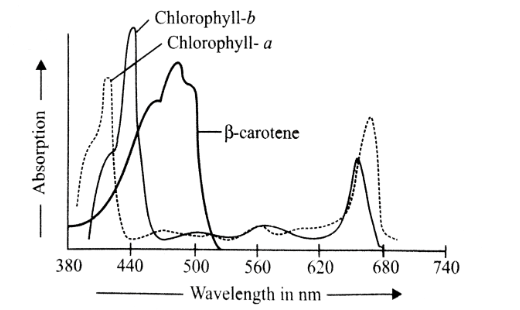
Select the correct statement regarding this.
CorrectIncorrectHint
(d) The graphical curve showing the amount of energy of different wavelengths of light absorbed by a pigment is called absorption spectrum. It is studied with the help of spectrophotometer. The absorption spectra of chlorophylls \(a\) and \(b\) show that they absorb maximum light in the blue-violet and red wavelengths. The pigments are often known after the wavelength which is absorbed to the maximum, e.g., \(\mathrm{Chl} a_{673}, \mathrm{Chl} a_{683}\left(\mathrm{~P}_{680}\right), \mathrm{Chl} a_{703}\left(\mathrm{~P}_{700}\right)\).
-
Question 19 of 96
19. Question
Accessory photosynthetic pigments in most green plants are
CorrectIncorrectHint
(d) Chlorophyll \(a\) is found in almost all photosynthetic plants except bacteria. It is called primary photosynthetic pigment because it performs primary reactions of photosynthesis which involve conversion of light energy into chemical energy. Other photosynthetic pigments like chlorophyll \(b\), xanthophylls and carotenes are called accessory pigments. They absorb light energy of different wavelengths, broaden the spectrum of light absorption and hand over the energy to chlorophyll a through electron spin resonance and also protect chlorophyll \(a\) from photo-oxidation.
-
Question 20 of 96
20. Question
Consider the below given figure and select the option that can be best concluded from it.
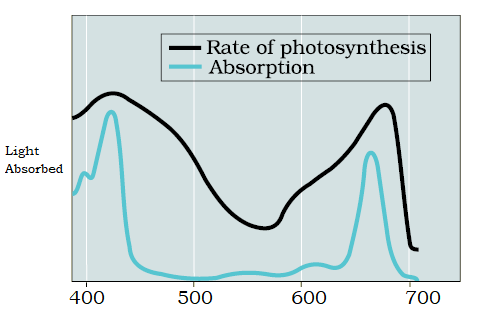 CorrectIncorrect
CorrectIncorrectHint
c
-
Question 21 of 96
21. Question
Which of the following is produced during the light phase of photosynthesis?
CorrectIncorrectHint
(c) Photochemical phase, also called light or Hill reaction, occurs inside the thylakoids, especially those of grana region. Photochemical step is dependent upon light. The function of this phase is to produce assimilatory power consisting of reduced coenzyme NADPH and energy rich ATP molecules.
-
Question 22 of 96
22. Question
Photochemical phase does not include
CorrectIncorrectHint
(d) The complete process of photosynthesis is studied under two phases – photochemical phase and biosynthetic phase. Photochemical phase involves absorption of light energy, photolysis of water with the release of \(\mathrm{O}_2\) and production of assimilatory power (i.e., ATP + NADPH). \(\mathrm{CO}_2\) fixation occurs during biosynthetic phase of photosynthesis.
-
Question 23 of 96
23. Question
The given figure depicts the light-harvesting complex (LHC) of photosystem I (PS I).
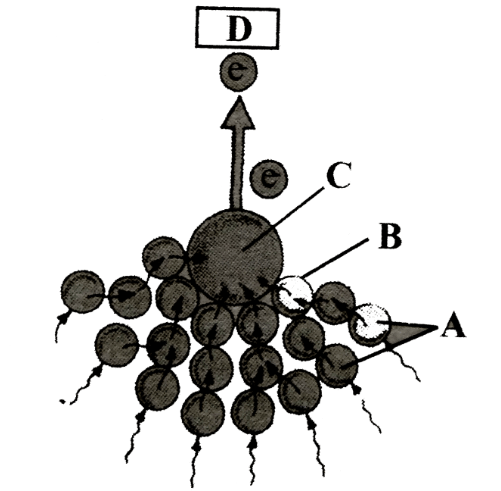 CorrectIncorrect
CorrectIncorrectHint
b
-
Question 24 of 96
24. Question
Reaction centre of PS I is and reaction centre of PS II is
CorrectIncorrectHint
(b) The reaction center of photosystem I (PS I) is referred to as \(P_{700}\), where “P” stands for “Pigment” and ” 700 ” stands for the wavelength of light that this particular chlorophyll molecule absorbs most strongly. The reaction center of photosystem II (PS II) is referred to as \(P_{680}\) for comparable reasons.
-
Question 25 of 96
25. Question
In PSI, the reaction centre \(\mathrm{Chl}\) a has absorption maxima at ; whereas in PS II, the reaction centre \(\mathrm{Chl}\) a has absorption maxima at
CorrectIncorrectHint
(a) The reaction center of photosystem I (PS I) is referred to as \(P_{700}\), where “P” stands for “Pigment” and ” 700 ” stands for the wavelength of light that this particular chlorophyll molecule absorbs most strongly. The reaction center of photosystem II (PS II) is referred to as \(P_{680}\) for comparable reasons.
-
Question 26 of 96
26. Question
Identify A, B, C, D and E in the given flow chart showing the Z-scheme of light reaction.
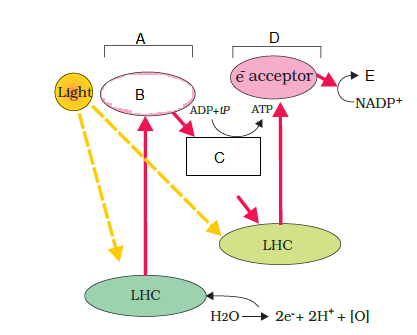 CorrectIncorrect
CorrectIncorrectHint
d
-
Question 27 of 96
27. Question
The biochemical objective of PS I is to
CorrectIncorrectHint
(d) During Z-scheme, the electron extruded by PS I passes through special chlorophyll \(X\), Fe-S, ferredoxin, to finally reach NADP+. \(\mathrm{NADP}^{+}\)is ultimately reduced by combining with \(\mathrm{H}^{+}\)(released during photolysis) with the help of NADP+ reductase enzyme.
-
Question 28 of 96
28. Question
Which one is involved in Z-scheme of photosynthesis?
CorrectIncorrectHint
(d) In non-cyclic photophosphorylation, the whole scheme of transfer of electrons, starting from the PS II, uphill to the acceptor, down the electron transport chain to PS I, excitation of electrons, transfer to another acceptor, and finally downhill to NADP+ causing it to be reduced to \(\mathrm{NADPH}+\mathrm{H}^{+}\)is called as the \(\mathrm{Z}\) scheme, due to its characteristic shape. This shape is formed when all the carriers are placed in a sequence on the redox potential scale.
-
Question 29 of 96
29. Question
For \(\mathrm{NADPH}+\mathrm{H}^{+}\)formation
CorrectIncorrectHint
(c) NADPH is formed during non-cyclic photophosphorylation wherein both PS I and PS II are involved.
-
Question 30 of 96
30. Question
Which of the following is/are formed during Z-scheme of photophosphorylation?
CorrectIncorrectHint
(d) In non-cyclic photophosphorylation, the whole scheme of transfer of electrons, starting from the PS II, uphill to the acceptor, down the electron transport chain to PS I, excitation of electrons, transfer to another acceptor, and finally downhill to NADP+ causing it to be reduced to \(\mathrm{NADPH}+\mathrm{H}^{+}\)is called as the \(\mathrm{Z}\) scheme, due to its characteristic shape. This shape is formed when all the carriers are placed in a sequence on the redox potential scale.
-
Question 31 of 96
31. Question
Select the correct option:
The \(\mathrm{Z}\) scheme of photophosphorylation follows the following sequence:
\(
\text { PS II } \underset{A}{\rightarrow} \mathrm{e}^{-} \text {acceptor } \underset{B}{\rightarrow} \text { ETS } \underset{B}{\rightarrow} \text { PS I } \underset{C}{\rightarrow} e^{-} \text {acceptor } \underset{\mathrm{D}}{\rightarrow} \text { NADP }^{+}
\)
Which of the following option for A, B, C and D transfer of electrons?CorrectIncorrectHint
a
-
Question 32 of 96
32. Question
During Z scheme, electrons excited by the absorption of light in PS I are transferred to the primary acceptors, and therefore must be replaced. The replacements come directly from
CorrectIncorrectHint
c
-
Question 33 of 96
33. Question
Refer to the given reaction.
\(
2 \mathrm{H}_2 \mathrm{O} \rightarrow 4 \mathrm{H}^{+}+\mathrm{O}_2+4 \mathrm{e}^{-}
\)
Where does this reaction take place in the chloroplasts of plants?CorrectIncorrectHint
(b) The splitting of water is associated with the PS II. Water split into \(\mathrm{H}^{+},[\mathrm{O}]\) and electrons. The electrons needed to replace those removed from photosystem I are provided by photosystem II.
\(
2 \mathrm{H}_2 \mathrm{O} \longrightarrow 4 \mathrm{H}^{+}+\mathrm{O}_2+4 e^{-}
\)
Water splitting complex is associated with the PSII, which itself is physically located on the inner side of the membrane of the thylakoid. The liberation of \(\mathrm{O}_2\) during photolysis of water involves the role of \(\mathrm{Mn}^{2+}, \mathrm{Ca}^{2+}\) and \(\mathrm{Cl}^2\) ions. -
Question 34 of 96
34. Question
Which one of the following ions is essential for photolysis of water?
CorrectIncorrectHint
(a) The splitting of water is associated with the PS II. Water split into \(\mathrm{H}^{+},[\mathrm{O}]\) and electrons. The electrons needed to replace those removed from photosystem I are provided by photosystem II.
\(
2 \mathrm{H}_2 \mathrm{O} \longrightarrow 4 \mathrm{H}^{+}+\mathrm{O}_2+4 e^{-}
\)
Water splitting complex is associated with the PSII, which itself is physically located on the inner side of the membrane of the thylakoid. The liberation of \(\mathrm{O}_2\) during photolysis of water involves the role of \(\mathrm{Mn}^{2+}, \mathrm{Ca}^{2+}\) and \(\mathrm{Cl}^2\) ions. -
Question 35 of 96
35. Question
During photocatalytic splitting of water, liberation of \(\mathrm{O}_2\) requires
CorrectIncorrectHint
(d) The splitting of water is associated with the PS II. Water split into \(\mathrm{H}^{+},[\mathrm{O}]\) and electrons. The electrons needed to replace those removed from photosystem I are provided by photosystem II.
\(
2 \mathrm{H}_2 \mathrm{O} \longrightarrow 4 \mathrm{H}^{+}+\mathrm{O}_2+4 e^{-}
\)
Water splitting complex is associated with the PSII, which itself is physically located on the inner side of the membrane of the thylakoid. The liberation of \(\mathrm{O}_2\) during photolysis of water involves the role of \(\mathrm{Mn}^{2+}, \mathrm{Ca}^{2+}\) and \(\mathrm{Cl}^2\) ions. -
Question 36 of 96
36. Question
_____ is the process of synthesis of ATP from ADP and \(\mathrm{Pi}\) in the presence of light.
CorrectIncorrectHint
(b) The process by which ATP is synthesised by cells (in mitochondria and chloroplasts) is named as phosphorylation. Photophosphorylation is the synthesis of ATP from ADP and inorganic phosphate \((P i)\) in the presence of light, inside chloroplast. Photophosphorylation is of two main types – Cyclic and non-cyclic photophosphorylation.
-
Question 37 of 96
37. Question
What does the given diagram represent with respect to the various photosynthetic processes?
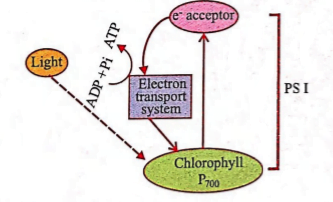 CorrectIncorrect
CorrectIncorrectHint
(b) The given diagram represents – cyclic photophosphorylation that involves only PS I.
-
Question 38 of 96
38. Question
PS II is located on
CorrectIncorrectHint
(a) PS II is present on innerside (appressed part) of thylakoid membrane.
-
Question 39 of 96
39. Question
Read the following statements and select the correct ones.
(i) PSI is involved in non-cyclic photophosphorylation only.
(ii) PS II is involved in both cyclic and non-cyclic photophosphorylation.
(iii) Stroma lamellae membranes possess PS I only, whereas grana lamellae membranes possess both PS I and PS II.CorrectIncorrectHint
(c) PSI is involved in both cyclic and non-cyclic photophosphorylation. PS II is involved only in non-cyclic photophosphorylation. PS II is present in the appressed (inner) part of grana thylakoids. PSI is located in the non- appressed (outer) part of grana thylakoids as well as stroma thylakoids.
-
Question 40 of 96
40. Question
Study the given flow chart of cyclic photophosphorylation and select the correct answer for A, B and C.
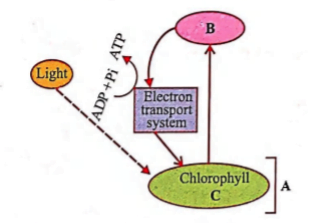 CorrectIncorrect
CorrectIncorrectHint
(c)
-
Question 41 of 96
41. Question
In cyclic photophosphorylation, the electron released by reaction centre \(\left(P_{700}\right)\) is ultimately accepted by
CorrectIncorrectHint
(c) In cyclic photophosphorylation, an electron expelled by the excited photocentre \(\left(P_{700}\right)\) is returned to it after passing through a series of electron carriers. Its photocentre \(P_{700}\) extrudes an electron with a gain of \(23 \mathrm{kcal} / \mathrm{mole}\) of energy after absorbing a photon of light (hv). After losing the electron the photocentre becomes oxidised. The expelled electron passes through a series of carriers including \(X\) or \(A_0\) (a special \(P_{700}\) chlorophyll molecule), \(A_1\) (a quinone), Fes complexes \(\left(\mathrm{FeS}_{\mathrm{X}}, \mathrm{FeS}_{\mathrm{A}}, \mathrm{FeS}_{\mathrm{B}}\right)\), ferredoxin \((\mathrm{Fd})\), plastoquinone \((\mathrm{PQ})\), cytochrome b-f complex and plastocyanin (PC) before returning to photo centre.
-
Question 42 of 96
42. Question
During non-cyclic photophosphorylation, electrons are continuously lost from the reaction centre of PS II. Which source is used to replace these electrons?
CorrectIncorrectHint
b
-
Question 43 of 96
43. Question
Read the given statements and select the correct option.
Statement 1: In photosynthesis, during ATP synthesis, protons accumulate in the lumen of the thylakoid.
Statement 2: In respiration, during ATP synthesis, protons accumulate in the intermembranal space of mitochondria.CorrectIncorrectHint
(a) In photosynthesis and respiration, ATP synthesis is linked to development of proton gradient across a membrane. The only difference is that in photosynthesis proton accumulation is towards the lumen of thylakoid and in respiration, proton accumulate in the intermembrane space of the mitochondria.
-
Question 44 of 96
44. Question
Cytochrome \(b_6\) and cytochrome \(f\) occur in
CorrectIncorrectHint
b
-
Question 45 of 96
45. Question
Identify the parts marked as A, B and C in the given figure showing ATP synthesis through chemiosmosis.
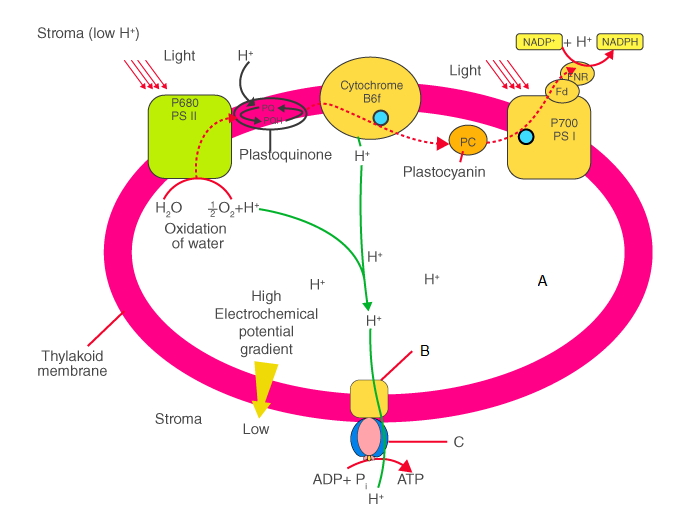
\(
\begin{array}{|l|l|l|l|}
\hline & \text { A } & \text { B } & \text { C } \\
\hline \text { (a) } & \text { Thylakoid lumen } & C F_0 & C F_1 \\
\hline \text { (b) } & \text { Thylakoid lumen } & C F_1 & C F_0 \\
\hline \text { (c) } & \text { Chloroplast lumen } & C F_0 & C F_1 \\
\hline \text { (d) } & \text { Chloroplast lumen } & C F_1 & C F_0 \\
\hline
\end{array}
\)CorrectIncorrectHint
(a) In the given figure, the ATP synthesis through chemiosmosis is shown. The electron transport chain forms a proton gradient across the inner mitochondrial membrane, which drives the synthesis of ATP through chemosmosis. Here A represents the thylakoid lumen. The ATP synthase consists of two functional domain: \(\mathrm{CF}_1\) situated in mitochondrial matrix and \(\mathrm{CF}_0\) located to the inner mitochondrial membrane. \(B\) represents \(C_0\) and \(C\) represents \(C F_1\).
-
Question 46 of 96
46. Question
Breakdown of proton gradient developed during chemiosmosis leads to the release of
CorrectIncorrectHint
c
-
Question 47 of 96
47. Question
During chemiosmotic synthesis of ATP, protons diffuse through \(\mathrm{CF}_0\) channels that activates ATPase enzyme. As a result, one molecule of ATP is formed when passes through ATPase.
CorrectIncorrectHint
c
-
Question 48 of 96
48. Question
Number of Calvin cycle required to generate 2 molecules of hexose sugar is
CorrectIncorrectHint
(c) For fixation of one sugar molecule, \(6 \mathrm{CO}_2\) molecules are required and for each \(\mathrm{CO}_2\) molecule, one Calvin cycle is run. Therefore 6 Calvin cycles are required for fixation of one molecule of sugar and 12 Calvin cycles are required for fixation of two molecules of sugar.
-
Question 49 of 96
49. Question
Which of the following statements about dark reactions is correct?
CorrectIncorrectHint
(c) Biosynthetic phase (Dark or Blackman’s reaction) catalyses the assimilation of \(\mathrm{CO}_2\) to carbohydrates. These reactions occur in stroma or matrix of chloroplasts and all the enzymes required for the processes are present in the stroma/matrix of chloroplasts. These reactions do not require light, instead assimilatory power (ATP and NADPH) produced during photochemical (light) phase is used in fixation and reduction of \(\mathrm{CO}_2\). However, this should not be construed to mean that they occur in darkness or that they are not light dependent.
-
Question 50 of 96
50. Question
The following table summarises the differences between light reactions and dark reactions.
\(
\begin{array}{|l|l|l|}
\hline & {\text { Light reactions }} & {\text { Dark reactions }} \\
\hline \text { (i) } & \begin{array}{l}
\text { These are also called } \\
\text { as biosynthetic } \\
\text { phase. }
\end{array} & \begin{array}{l}
\text { These are also called } \\
\text { as photochemical } \\
\text { phase. }
\end{array} \\
\hline \text { (ii) } & \begin{array}{l}
\text { These reactions } \\
\text { occur over } \\
\text { thylakoids. }
\end{array} & \begin{array}{l}
\text { These reactions } \\
\text { occur in stroma of } \\
\text { chloroplasts. }
\end{array} \\
\hline \text { (iii) } & \begin{array}{l}
\text { These produce } \\
\text { assimilatory power i.e., } \\
\text { NADPH and ATP. }
\end{array} & \begin{array}{l}
\text { These consume NADPH } \\
\text { and ATP. }
\end{array} \\
\hline \text { (iv) } & \begin{array}{l}
\text { These are directly } \\
\text { dependent upon } \\
\text { light. }
\end{array} & \begin{array}{l}
\text { These depend upon the } \\
\text { products synthesised } \\
\text { during light reactions. }
\end{array} \\
\hline
\end{array}
\)Which of the above pairs of differences is/are incorrect?
CorrectIncorrectHint
(d) Light reactions are also called as photochemical phase whereas dark reactions are called as biosynthetic phase.
-
Question 51 of 96
51. Question
If green plant cells are incubated with \(0^{18}\)-labelled \(\mathrm{CO}_2\), which of the following molecules will become radioactive when the cells are exposed to light?
CorrectIncorrectHint
c
-
Question 52 of 96
52. Question

Select the option that correctly identifies \(X, Y\) and \(Z\)
\(
\begin{array}{|l|l|l|l|}
\hline & \text { X } & \text { Y } & \text { Z } \\
\hline \text { (a) } & \text { Stroma } & \text { Grana } & \text { Chloroplast DNA } \\
\hline \text { (b) } & \text { Stroma } & \text { Grana } & \text { Starch granule } \\
\hline \text { (c) } & \text { Grana } & \text { Stroma } & \text { Starch granule } \\
\hline \text { (d) } & \text { Grana } & \text { Stroma } & \text { Chloroplast DNA } \\
\hline
\end{array}
\)CorrectIncorrectHint
c
-
Question 53 of 96
53. Question
Select the option that correctly identifies \(X, Y\) and \(Z\)
 CorrectIncorrect
CorrectIncorrectHint
(b) Light reactions (or photochemical phase) of photosynthesis mainly occur on the grana thylakoids. Dark reactions (or biosynthetic phase) which involve synthesis of carbohydrates by \(\mathrm{CO}_2\) fixation, occur in the stroma (or matrix) of chloroplasts. The chloroplast matrix of higher plants stores starch temporarily in the form of starch granules.
-
Question 54 of 96
54. Question
In the given representation of Calvin cycle, identify A, B and C and select the correct option.
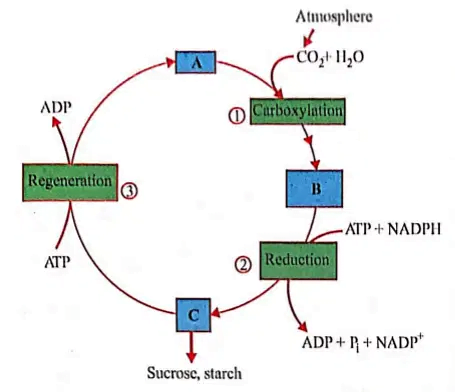
\(
\begin{array}{|l|l|l|l|}
\hline & \text { A } & \text { B } & \text { C } \\
\hline \text { (a) } & \text { 3PGA } & \text { RuBP } & \text { Triose phosphate } \\
\hline \text { (b) } & \text { RuBP } & \text { 3PGA } & \text { Triose phosphate } \\
\hline \text { (c) } & \text { PEP } & \text { OAA } & \text { Malic acid } \\
\hline \text { (d) } & \text { PEP } & \text { RuBP } & \text { OAA } \\
\hline
\end{array}
\)CorrectIncorrectHint
(b)
-
Question 55 of 96
55. Question
Read the given statements and select the correct option.
Statement 1: Carboxylation is the most crucial step of Calvin cycle where \(\mathrm{CO}_2\) is utilised for the carboxylation of RuBP.
Statement 2: Carboxylation is catalysed by the enzyme RuBisCO which results in the formation of two molecules of \(3 P G A\).CorrectIncorrectHint
(a) Carboxylation is the fixation of \(\mathrm{CO}_2\) into a stable organic intermediate. It is the most crucial step of Calvin cycle where \(\mathrm{CO}_2\) is utilised for the carboxylation of RuBP through the use of ATP and NADPH generated by the light reactions. This reaction is catalysed by enzyme RuBis \(\mathrm{CO}\) which results in the formation of two molecules of 3-phosphoglyceric acid or PGA, which is the first stable product of photosynthesis.
-
Question 56 of 96
56. Question
Identify the correct sequence of stages of Calvin cycle.
CorrectIncorrectHint
c
-
Question 57 of 96
57. Question
\(\mathrm{CO}_2\) combines with RuBP in the presence of enzyme RuBisCO to form 3-PGA. This process of Calvin cycle is included under
CorrectIncorrectHint
(a) Carboxylation is the fixation of \(\mathrm{CO}_2\) into a stable organic intermediate. It is the most crucial step of Calvin cycle where \(\mathrm{CO}_2\) is utilised for the carboxylation of RuBP through the use of ATP and NADPH generated by the light reactions. This reaction is catalysed by enzyme RuBis \(\mathrm{CO}\) which results in the formation of two molecules of 3-phosphoglyceric acid or PGA, which is the first stable product of photosynthesis.
-
Question 58 of 96
58. Question
RuBisCO is
CorrectIncorrectHint
(c) The enzyme RuBisCO carries out photosynthetic carboxylation of RuBP. The enzyme was previously called as carboxydismutase. RuBisCO is the most abundant protein of the biological world. RuBisCO is located in the stroma on the outer surface of thylakoid membranes. As it is capable of carrying out both carboxylation and oxygenation reactions in \(C_3\) and \(C_4\) plants respectively, thus it is correctly named as RuBP carboxylaseoxygenase.
-
Question 59 of 96
59. Question
Glucose synthesis occurs during which stage of \(C_3\) cycle?
CorrectIncorrectHint
(c) During reduction stage of \(C_3\) cycle, a series of reactions lead to the formation of glucose. The steps involve utilisation of two molecules of ATP for phosphorylation and two of NADPH for reduction per \(\mathrm{CO}_2\) molecule fixed. The fixation of six molecules of \(\mathrm{CO}_2\) and 6 turns of the cycle are required for the removal of one molecule of glucose from the pathway.
-
Question 60 of 96
60. Question
During fixation of one molecule of \(\mathrm{CO}_2\) by \(\mathrm{C}_3\) plants, number of ATP and NADPH required are
CorrectIncorrectHint
(a) For every \(\mathrm{CO}_2\) molecule entering the Calvin cycle, 3 molecules of ATP and 2 molecules of NADPH are required. To make one molecule of glucose, 6 turns of the cycles are required \((6 \times 3\) ATP \(=18[latex] ATP and [latex]6 \times 2 \mathrm{NADPH}=12 \mathrm{NADPH})\).
-
Question 61 of 96
61. Question
How many ATP and NADPH molecules are respectively required to make one molecule of glucose through Calvin cycle?
CorrectIncorrectHint
(c) For every \(\mathrm{CO}_2\) molecule entering the Calvin cycle, 3 molecules of ATP and 2 molecules of NADPH are required. To make one molecule of glucose, 6 turns of the cycles are required \((6 \times 3\) ATP \(=18[latex] ATP and [latex]6 \times 2 \mathrm{NADPH}=12 \mathrm{NADPH})\).
-
Question 62 of 96
62. Question
How many number of \(\mathrm{CO}_2\) molecules are required to synthesise one molecule of glucose during \(\mathrm{C}_3\) cycle?
CorrectIncorrectHint
(c) Six molecules of \(\mathrm{CO}_2\) are required to synthesise one molecule of glucoses, each of which undergoes a \(\mathrm{C}_3\) cycle. Hence, 6 molecules of \(\mathrm{CO}_2\) synthesise a glucose molecule after 6 turns of Calvin cycle.
-
Question 63 of 96
63. Question
Which of the following statements is incorrect regarding the Calvin cycle of \(\mathrm{C}_3\) plants?
CorrectIncorrectHint
(c) \(\ln C_3\) plants, bundle sheath cells usually do not contain chloroplasts and the whole \(C_3\) cycle operates in mesophyll cells of leaves.
-
Question 64 of 96
64. Question
Kranz anatomy is not exhibited by which of the following plants?
CorrectIncorrectHint
(d) Kranz anatomy is shown by \(\mathrm{C}_4\) plants such as Sorghum, sugarcane, maize, Cyperus rotundus, etc.
-
Question 65 of 96
65. Question
Select the incorrect statement with respect to kranz anatomy.
CorrectIncorrectHint
(d) Kranz anatomy is a characteristic of \(\mathrm{C}_4\) plants. In kranz anatomy, the mesophyll is undifferentiated and its cells occur in concentric layers around vascular bundles. Vascular bundles are surrounded by large sized bundle sheath cells which are arranged in a wreath-like manner in one to several layers. The chloroplasts of mesophyll cells are smaller, they have well-developed grana and a peripheral reticulum but no starch.
-
Question 66 of 96
66. Question
Select the correct statement regarding the first stable product formed in Hatch and Slack pathway in \(\mathrm{C}_4\) plants.
CorrectIncorrectHint
b
-
Question 67 of 96
67. Question
Consider following statements with respect to the \(C_4\) pathway and select the correct ones.
(i) Mesophyll cells possess both RuBisCO and PEPcase enzymes.
(ii) Initial \(\mathrm{CO}_2\) fixation occurs in mesophyll cells.
(iii) Final \(\mathrm{CO}_2\) fixation occurs in bundle sheath cells.CorrectIncorrectHint
(b) Mesophyll cells in \(C_4\) plants are specialised to perform light reaction, evolve \(\mathrm{O}_2\) and produce assimilatory power. They possess enzyme PEPCase for initial fixation of \(\mathrm{CO}_2\).
-
Question 68 of 96
68. Question
In \(C_4\) plants, Calvin cycle enzymes are present in
CorrectIncorrectHint
(b) In \(C_4\) plants, Calvin cycle enzymes are present in chloroplasts of bundle sheath cells.
-
Question 69 of 96
69. Question
During Hatch and Slack pathway, PEP combines with \(\mathrm{CO}_2\) in the presence of enzyme PEPCase, to form OAA. This process of initial fixation of \(\mathrm{CO}_2\) occurs in
CorrectIncorrectHint
(a) In \(C_4\) plants showing Hatch-Slack cycle, initial fixation of \(\mathrm{CO}_2\) occurs in mesophyll cells followed by final fixation in bundle sheath cells.
-
Question 70 of 96
70. Question
Given figure represents \(C_4\) pathway. Select the suitable options for \(A, B\) and \(C\).
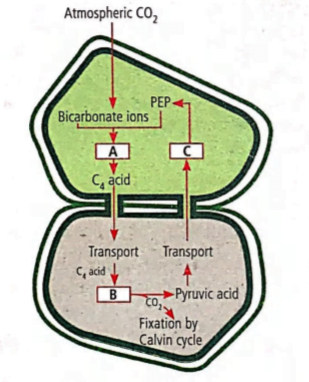
\(
\begin{array}{|l|l|l|l|}
\hline & \text { A } & \text { B } & \text { C } \\
\hline \text { (a) } & \text { Decarboxylation } & \text { Reduction } & \text { Regeneration } \\
\hline \text { (b) } & \text { Fixation } & \text { Transamination } & \text { Regeneration } \\
\hline \text { (c) } & \text { Carboxylation } & \text { Decarboxylation } & \text { Reduction } \\
\hline \text { (d) } & \text { Fixation } & \text { Decarboxylation } & \text { Regeneration } \\
\hline
\end{array}
\)CorrectIncorrectHint
d
-
Question 71 of 96
71. Question
Which kind of cells are represented by letters \(P\) and \(Q\) in the given figure showing \(\mathrm{C}_4\) pathway?
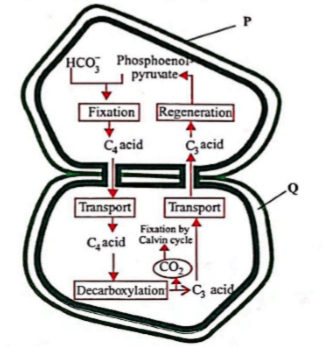
\(
\begin{array}{|l|l|l|}
\hline & \text { P } & \text { Q } \\
\hline \text { (a) } & \text { Palisade parenchyma } & \text { Spongy parenchyma } \\
\hline \text { (b) } & \text { Spongy parenchyma } & \text { Palisade parenchyma } \\
\hline \text { (c) } & \text { Mesophyll cell } & \text { Bundle sheath cell } \\
\hline \text { (d) } & \text { Bundle sheath cell } & \text { Mesophyll cell } \\
\hline
\end{array}
\)CorrectIncorrectHint
c
-
Question 72 of 96
72. Question
In an experiment in which photosynthesis is performed during the day, you provide a plant with radioactive carbon dioxide \(\left({ }^{14} \mathrm{CO}_2\right)\) as a metabolic tracer. The \({ }^{14} \mathrm{C}\) is incorporated first into oxaloacetic acid. The plant is best characterised as a
CorrectIncorrectHint
(a) In \(\mathrm{C}_4\) plants, the first stable photosynthetic product is a 4-carbon compound, i.e., oxaloacetic acid (OAA), which is formed by initial fixation of \(\mathrm{CO}_2\) by the carboxylation of phosphoenol pyruvate in the mesophyll cells. So, when radioactive \({ }^{14} \mathrm{CO}_2\) is introduced into the reaction, it is first incorporated into the OAA.
\(
\text { PEP }+{ }^{14} \mathrm{CO}_2+\mathrm{H}_2 \mathrm{O} \stackrel{\text { PEP carboxylase }}{\longrightarrow} \mathrm{OAA}+\mathrm{H}_3 \mathrm{PO}_4
\)
In a CAM plant, although the first product formed is OAA, but here the initial \(\mathrm{CO}_2\) fixation occurs at night. -
Question 73 of 96
73. Question
Select the incorrect pair.
CorrectIncorrectHint
(a) Both malic acid and aspartic acid are 4 -carbon compounds formed in the mesophyll cells during \(\mathrm{C}_4\) cycle. PGA (3-phosphoglyceric acid) is a 3-carbon compound, which is the first stable product of Calvin cycle \(\left(\mathrm{C}_3\right.\) cycle). RuBP (Ribulose-1,5-biphosphate) is a 5-carbon compound, which is the primary acceptor of \(\mathrm{CO}_2\) during \(\mathrm{C}_3\) cycle.
-
Question 74 of 96
74. Question
Optimum temperature conditions for photosynthesis in \(\mathrm{C}_3\) and \(\mathrm{C}_4\) plants are respectively
CorrectIncorrectHint
a
-
Question 75 of 96
75. Question
Match column I with column II and select the correct option from the given codes.
\(
\begin{array}{|l|l|l|l|}
\hline & \text { Column I } & & \text { Column II } \\
\hline \text { A. } & \text { C }_3 \text { plants } & \text { (i) } & \text { Kalanchoe, Opuntia } \\
\hline \text { B. } & \text { C }_4 \text { plants } & \text { (ii) } & \text { Maize, sugarcane } \\
\hline \text { C. } & \text { CAM plants } & \text { (iii) } & \text { Helianthus } \\
\hline
\end{array}
\)CorrectIncorrectHint
c
-
Question 76 of 96
76. Question
Match column I with column II and select the correct option from the given codes.
\(
\begin{array}{|l|l|r|l|}
\hline & \text { Column I } & & \text { Column II } \\
\hline \text { A. } & \mathrm{C}_4 \text { plants } & \text { (i) } & \text { Succulents } \\
\hline \text { B. } & \text { Chlorophyll b } & \text { (ii) } & \begin{array}{l}
\text { Accessory photosynthetic } \\
\text { pigment }
\end{array} \\
\hline \text { C. } & \text { PS II } & \text { (iii) } & \text { Photooxidation of } \mathrm{H}_2 \mathrm{O} \\
\hline \text { D. } & \text { CAM } & \text { (iv) } & \text { Kranz anatomy } \\
\hline
\end{array}
\)CorrectIncorrectHint
a
-
Question 77 of 96
77. Question
At mild temperature, the enzyme RuBisCO has
CorrectIncorrectHint
(a) At mild temperature, RuBis \(\mathrm{CO}\) has high affinity for \(\mathrm{CO}_2\) that is about 80 times higher than its affinity for oxygen. In addition, RuBis \(\mathrm{CO}\) has higher affinity for \(\mathrm{O}_2\) when temperature increases.
-
Question 78 of 96
78. Question
Refer the given reaction
\(
\text { RuBP }+\mathrm{O}_2 \underset{\text { axygenase }}{\stackrel{\text { RuBP }}{\longrightarrow}} \begin{gathered}
\text { Phosphoglyceric } \\
\text { acid }
\end{gathered}+\begin{gathered}
\text { Phosphoglycolic } \\
\text { acid }
\end{gathered}
\)It is the first reaction of
CorrectIncorrectHint
(c) At high temperature, RuBisCO functions as oxygenase and instead of fixing \(\mathrm{CO}_2\), oxidises RuBP to produce a \(3-\mathrm{C}\) phosphoglyceric acid and a 2-C phosphoglycolate. This is the first reaction of photorespiration or \(C_2\) cycle.
-
Question 79 of 96
79. Question
Read the given statements and select the correct option.
Statement 1: Photorespiration interferes with the successful functioning of Calvin cycle.
Statement 2: Photorespiration oxidises ribulose-1,5 biphosphate which is an acceptor of \(\mathrm{CO}_2\) in Calvin cycle.CorrectIncorrectHint
(a) Photorespiration (Photosynthetic carbon oxidative or PCO cycle) is the light dependent process of oxygenation of ribulose-1, 5-biphosphate (RuBP) and release of \(\mathrm{CO}_2\) by the photosynthetic organs of a plant. Under normal conditions, in Calvin cycle, carboxylation of RuBP takes place whereas during photorespiration instead of carboxylation, oxygenation of RuBP takes place. This is due to abnormal behaviour of enzyme RuBisCO, which at high temperature (more than \(35^{\circ} \mathrm{C}\) ), functions as oxygenase (instead of carboxylase). Instead of fixing \(\mathrm{CO}_2\), it performs oxygenation of RuBP to produce a 3-carbon phosphoglyceric acid (PGA) and a 2-carbon phosphoglycolate. It is the first reaction of photorespiration and can be represented as :
\(
\text { RuBP }+\mathrm{O}_2 \underset{\text { oxygenase }}{\stackrel{\text { RuBP }}{\longrightarrow}} \mathrm{PGA}+\text { Phosphoglycolate }
\)
In this way, photorespiration interferes with the successful functioning of Calvin cycle by causing oxygenation of RuBP instead of carboxylation. -
Question 80 of 96
80. Question
How many ATP and NADPH are respectively produced in the process of photorespiration?
CorrectIncorrectHint
(d) Photorespiratory pathway (or \(C_2\) pathway) results in the release of \(\mathrm{CO}_2\) with the utilisation of ATP. In the photorespiratory pathway, there is no synthesis of ATP or NADPH.
-
Question 81 of 96
81. Question
During \(\mathrm{C}_2\) cycle, there occurs
CorrectIncorrectHint
(b) Photorespiratory pathway (or \(C_2\) pathway) results in the release of \(\mathrm{CO}_2\) with the utilisation of ATP. In the photorespiratory pathway, there is no synthesis of ATP or NADPH.
-
Question 82 of 96
82. Question
Which organelle out of these does not participate in photorespiration?
CorrectIncorrectHint
(d) The site for photorespiration is chloroplast, peroxisome and mitochondrion.
-
Question 83 of 96
83. Question
The ‘law of limiting factors’ was given by in the year
CorrectIncorrectHint
(a) Blackman’s (1905) law of limiting factors states that if a chemical process is affected by more than one factor, then its rate will be determined by the factor which is nearest to its minimal value; it is the factor which directly affects the process if its quantity is changed.
-
Question 84 of 96
84. Question
Study the given graph showing the effect of light intensity on the rate of photosynthesis. Which of the following statements regarding this is correct?
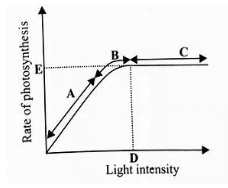 CorrectIncorrect
CorrectIncorrectHint
(d) A limiting factor is defined as a factor which is deficient to such an extent that increase in its magnitude directly increases the rate of the process.
In the given graph, rate of photosynthesis initially increases with an increase in light intensity (region A) but soon it levelled off. Thus, initially light intensity was limiting the rate of photosynthesis. However, when light intensity was present in sufficient amounts (region C), rate of photosynthesis did not increase further. This is due to the fact that in region \(\mathrm{C}\), some other factor (e.g. \(\mathrm{CO}_2\) concentration) became the limiting factor. At this region, the rate of photosynthesis could be further enhanced only by the increase in availability of other limiting factor \(\left(e, g . \mathrm{CO}_2\right)\). -
Question 85 of 96
85. Question
Quality of light refers to
CorrectIncorrectHint
c
-
Question 86 of 96
86. Question
Given table shows the \(\mathrm{CO}_2\) compensation point and optimum \(\mathrm{CO}_2\) concentration for photosynthesis for \(\mathrm{C}_3\) and \(\mathrm{C}_4\) plants.
\(
\begin{array}{|l|c|c|}
\hline {\text { Parameters }} & \mathrm{C}_3 \text { Plants } & \mathrm{C}_4 \text { Plants } \\
\hline \begin{array}{l}
\mathrm{CO}_2 \text { compensation } \\
\text { point }
\end{array} & 25-100 \mathrm{ppm} & \text { A } \\
\hline \begin{array}{l}
\text { Optimum } \mathrm{CO}_2 \\
\text { concentration }
\end{array} & \text { B } & 360 \mathrm{ppm} \\
\hline
\end{array}
\)Select the correct values for A and B.
CorrectIncorrectHint
(b) \(\mathrm{CO}_2\) compensation point or threshold value is that concentration of \(\mathrm{CO}_2\) at which illuminated plant parts stop absorbing carbon dioxide from their environment. At this value, \(\mathrm{CO}_2\) fixed in photosynthesis is equal to \(\mathrm{CO}_2\) evolved in respiration and photorespiration. The value is \(25-100 \mathrm{ppm}\) in \(\mathrm{C}_3\) plants and \(0-10\) ppm in \(\mathrm{C}_4\) plants. The reason for low compensation value for \(\mathrm{C}_4\) plants is the greater efficiency of \(\mathrm{CO}_2\)-fixation through PEP-carboxylase. The optimum \(\mathrm{CO}_2\) concentration for \(\mathrm{C}_4\) plants is \(360 \mathrm{ppm}\) and for \(\mathrm{C}_3\) plants, it is \(450 \mathrm{ppm}\).
-
Question 87 of 96
87. Question
When the temperature is increased from minimum to optimum, the rate of photosynthesis doubles for every _____ rise in temperature.
CorrectIncorrectHint
(b) Rate of photosynthesis usually increases with an increase in temperature upto \(40^{\circ} \mathrm{C}\). Above this temperature, rate of photosynthesis starts decreasing due to inactivation of enzymes. The minimum temperature at which most plants start photosynthesis is \(0^{\circ}\) \(-5^{\circ} \mathrm{C}\) but it can be as low as \(-20^{\circ} \mathrm{C}\) for lichens and \(-35^{\circ} \mathrm{C}\) for some gymnosperms. The maximum temperature at which photosynthesis can occur is \(55^{\circ} \mathrm{C}\) in some desert plants and \(75^{\circ} \mathrm{C}\) for hot spring algae. When temperature is increased from minimum to optimum, the rate of photosynthesis doubles for every \(10^{\circ} \mathrm{C}\) rise in temperature.
-
Question 88 of 96
88. Question
Tropical plants have a _____ temperature optimum than the plants adapted to temperate climates.
CorrectIncorrectHint
(c) The \(C_4\) plants respond to higher temperatures and show higher rate of photosynthesis while \(C_3\) plants have a much lower temperature optimum. The temperature optimum for photosynthesis of different plants depends on the habitat that they are adapted to. Tropical plants have a higher temperature optimum than the plants adapted to temperate climates as tropical areas have higher temperature as compared to temperate areas.
-
Question 89 of 96
89. Question
Which of the following factors, besides being one of the reactants in the process of photosynthesis, indirectly affects its rate?
CorrectIncorrectHint
(c) Water indirectly affects the process of photosynthesis by causing water stress due to its unavailability. It causes closing of stomata which further results in \(\mathrm{CO}_2\) unavailability and hence affecting photosynthesis.
-
Question 90 of 96
90. Question
Which of the following is not an external factor influencing photosynthesis?
CorrectIncorrectHint
(d) The process of photosynthesis is influenced by several factors, which include both internal (plant) and external (environmental) factors. The plant factors include the number, size, age and orientation of leaves, presence or absence of hormones, leaf anatomy, amount of chlorophyll, etc. The external factors would include the availability of sunlight, temperature, concentration of \(\mathrm{CO}_2\) and \(\mathrm{O}_2\) and water.
-
Question 91 of 96
91. Question
The factor which is not limiting in normal conditions for photosynthesis is
CorrectIncorrectHint
b
-
Question 92 of 96
92. Question
Consider the following statements regarding starch and sucrose synthesis during day time and select the correct ones.
(i) Triose phosphate is confined to chloroplast and is utilised for the synthesis of starch only.
(ii) Triose phosphate is translocated to cytosol from chloroplast.
(iii) Triose phosphate is utilised for the synthesis of both starch and sucrose.
(iv) Triose phosphate is translocated from cytosol to chloroplast.CorrectIncorrectHint
(b) Glyceraldehyde-3-phosphate (G3P) or 3-phosphoglyceraldehyde (PGAL), also known as triose phosphate, is a chemical compound that occurs as an intermediate in several central metabolic pathways of all organisms. It is an intermediate in photosynthesis. A part of triose phosphate is translocated to cytosol from chloroplast and is utilised for the synthesis of glucose, sucrose, starch, etc.
-
Question 93 of 96
93. Question
Refer to the given cross-section of a \(\mathrm{C}_4\) leaf and select the incorrect option.
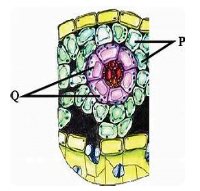 CorrectIncorrect
CorrectIncorrectHint
(d) The given cross section of the leaf represents kranz anatomy in a \(\mathrm{C}_4\) plant. \(P\) are the chloroplasts of mesophyll cells, which are granal (i.e, thylakoids are stacked to form grana) and are specialised to perform light reaction of photosynthesis, evolve \(\mathrm{O}_2\) and produce assimilatory power (ATP + NADPH). Q are the chloroplasts of bundle sheath cells which are agranal, i.e., grana are absent and the thylakoids occur as stroma lamellae. In these chloroplasts, final fixation of \(\mathrm{CO}_2\) takes place through Calvin cycle where \(\mathrm{CO}_2\) is fixed by RuBP in the presence of enzyme RuBisCO.
-
Question 94 of 96
94. Question
When wheat and sugarcane leaves are fed with radioactive \({ }^{14} \mathrm{CO}_2\), in which molecule would the radioactivity appear first in these plants?
\(
\begin{array}{|l|l|l|}
\hline & \text { Wheat } & \text { Sugarcane } \\
\hline \text { (a) } & \text { 3-Phosphoglycerate } & \text { Oxaloacetate } \\
\hline \text { (b) } & \text { 3-Phosphoglycerate } & \text { 3-Phosphoglycerate } \\
\hline \text { (c) } & \text { Oxaloacetate } & \text { Oxaloacetate } \\
\hline \text { (d) } & \text { Malate } & \text { 3-Phosphoglycerate } \\
\hline
\end{array}
\)CorrectIncorrectHint
(a) Wheat is a \(C_3\) plant and sugarcane is a \(C_4\) plant. In a \(C_3\) plant, first product of photosynthesis is 3-phosphoglycerate whereas in a \(C_4\) plant, first product of photosynthesis is a \(4-C\) organic acid i.e., oxaloacetic acid which is reduced to malic acid (malate) or transaminated to form aspartate. In sugarcane, after exposure to \({ }^{14} \mathrm{CO}_2\) for approximately one second, more than \(94 \%\) of fixed radioactivity is found to be present in malate, aspartate and oxaloacetate.
-
Question 95 of 96
95. Question
The given diagram represents the Calvin cycle.

At which stage is \(\mathrm{CO}_2\) incorporated?
CorrectIncorrectHint
(a) Carboxylation is the most crucial step of Calvin cycle where \(\mathrm{CO}_2\) is utilised for carboxylation of RuBP. This reaction is catalysed by enzyme RuBP carboxylase which results in the formation of 2 molecules of \(3-P G A\).
-
Question 96 of 96
96. Question
A typical light response curve of photosynthesis is shown. The limiting factor/s for photosynthesis at \(M\) and \(\mathrm{N}\) is/are
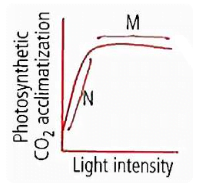 CorrectIncorrect
CorrectIncorrectHint
(b) At N, rate of photosynthesis in increasing with increasing light intensity so light is limiting the rate of photosynthesis. After \(\mathrm{N}\), i.e., at M rate of photosynthesis does not increase further even on increasing the light intensity. It implies that some other factor like \(\mathrm{CO}_2\) is now limiting the rate of photosynthesis.